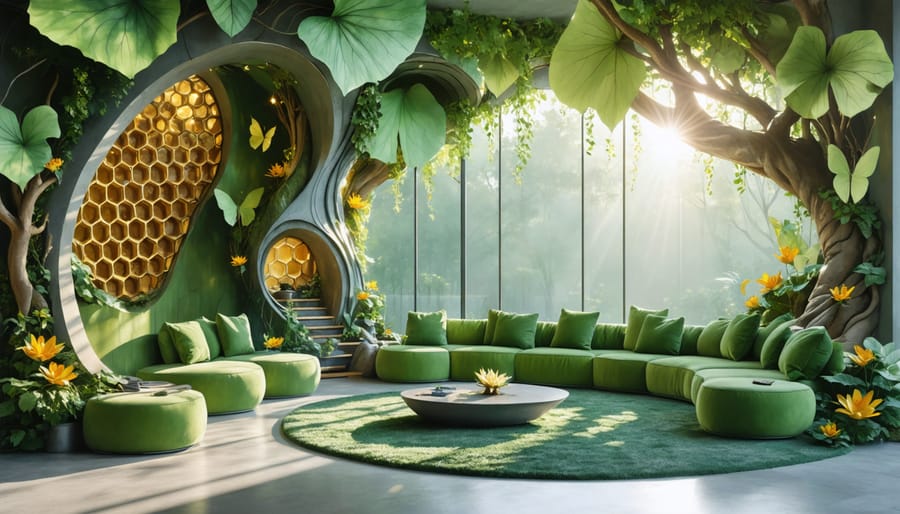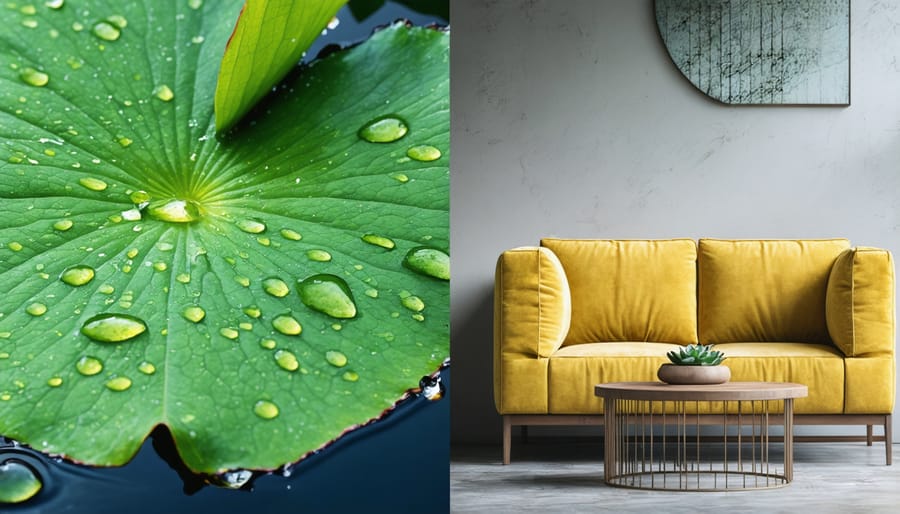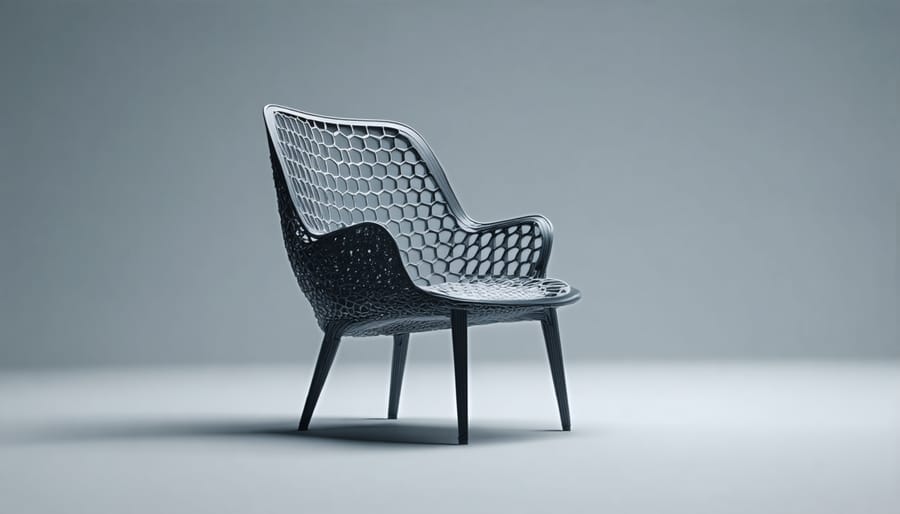
Nature’s 3.8 billion years of evolutionary innovation holds the key to revolutionary interior design solutions. From honeycomb-structured storage systems that maximize space efficiency to self-cleaning surfaces inspired by lotus leaves, biomimicry transforms ordinary rooms into extraordinary living spaces that work smarter, not harder.
Modern designers now replicate nature’s most successful adaptations in everything from lighting fixtures that mimic the light-dispersing properties of butterfly wings to ventilation systems that follow the efficient airflow patterns of termite mounds. These bio-inspired innovations don’t just create visually stunning spaces – they deliver measurable improvements in energy efficiency, air quality, and occupant wellbeing.
The genius of biomimicry lies in its practical application. Furniture with tree-like load-bearing structures requires less material while maintaining superior strength. Wall textures based on shark skin naturally resist bacterial growth. Even color schemes drawn from natural habitats have been proven to reduce stress and enhance productivity. By understanding and implementing these time-tested natural strategies, we’re not just designing spaces – we’re creating environments that inherently support human health and comfort while minimizing environmental impact.
Drawing inspiration from the remarkable self-healing properties of plant cell walls, innovative furniture manufacturers have developed materials that can automatically repair minor scratches, dents, and surface damage. These revolutionary surfaces incorporate specially engineered polymers that respond to pressure and temperature changes, much like how plants naturally heal their protective layers.
When minor damage occurs, these smart materials activate their self-repair mechanisms through either heat application or simple pressure. The molecular structure reorganizes itself, effectively “healing” scratches and small imperfections within hours. This technology is particularly valuable in high-traffic areas where furniture regularly faces wear and tear.
Commercial applications include table tops, counter surfaces, and cabinet fronts that maintain their pristine appearance with minimal maintenance. The self-healing capability can extend furniture life by up to 30% compared to traditional materials, resulting in significant cost savings over time. While these surfaces can’t repair major damage, they excel at addressing the everyday scuffs and marks that typically accumulate on well-used furniture pieces.
This advancement represents a significant step forward in sustainable furniture design, reducing the need for repairs and refinishing while maintaining aesthetic appeal.
Nature’s remarkable self-cleaning properties, exemplified by the lotus leaf, have inspired revolutionary surface finishes that make furniture maintenance easier than ever. The lotus effect, characterized by water droplets that roll off leaves while collecting dirt particles, has been successfully replicated in modern coating technologies.
These innovative finishes feature microscopic textures that create a water-repellent surface, causing liquids to bead up and roll away instead of settling and staining. This natural defense mechanism not only protects against water damage but also significantly reduces the accumulation of dust and dirt, making regular cleaning more efficient.
Manufacturers now offer furniture pieces and surface treatments that incorporate lotus-effect technology, particularly beneficial for high-traffic areas and spaces prone to spills. From dining tables to kitchen cabinets, these finishes provide lasting protection while maintaining the furniture’s aesthetic appeal.
Property managers and homeowners report spending up to 70% less time on maintenance when using lotus-effect treated surfaces. The technology is especially valuable in commercial settings where maintaining a pristine appearance is crucial for business success.

Nature’s most efficient structural design, the honeycomb, has revolutionized modern furniture manufacturing by offering an ingenious solution to the age-old challenge of creating strong yet lightweight furniture. This remarkable pattern, found in bee hives, combines minimal material usage with maximum structural integrity.
Furniture designers have embraced honeycomb core technology in everything from table tops to cabinet doors. The structure consists of small, hexagonal cells that work together to distribute weight evenly across the surface. This natural geometry allows pieces to maintain exceptional strength while reducing overall material costs and weight by up to 30% compared to solid construction methods.
The benefits extend beyond just structural advantages. Honeycomb-core furniture is easier to move and transport, reducing the risk of injury during relocation. It’s also more environmentally friendly, using less raw material while maintaining durability. For commercial spaces, this translates to reduced shipping costs and easier installation.
Recent innovations have improved upon this design by incorporating sustainable materials like recycled cardboard and bamboo into honeycomb cores. These advancements provide excellent stability while meeting growing demands for eco-conscious furniture solutions. The result is furniture that’s not only structurally sound but also aligned with modern sustainability goals.
When properly maintained, honeycomb-structured furniture can last for decades, making it a smart investment for both residential and commercial spaces.

Nature’s master architects, spiders, have inspired a revolution in furniture design that combines strength with incredible flexibility. Modern furniture makers are incorporating web-like structural patterns that distribute weight and tension across multiple points, much like a spider’s web. This innovative approach results in chairs, tables, and other pieces that can withstand significant stress while maintaining their shape and integrity.
These spider-inspired designs typically feature interconnected support systems made from high-tensile materials like carbon fiber or specialized polymers. The result is furniture that’s not only structurally sound but also remarkably lightweight. For example, modern patio furniture using this technology can withstand various weather conditions while remaining easy to move and maintain.
The genius of spider web-based design lies in its ability to flex without breaking. When pressure is applied to one area, the force is distributed throughout the entire structure, preventing weak points from developing. This characteristic makes such furniture particularly valuable in high-traffic areas or spaces where furniture needs to accommodate different body types and usage patterns.
Commercial spaces have embraced this technology for its longevity and reduced maintenance requirements. The flexible framework means less strain on individual components, resulting in furniture that maintains its appearance and functionality far longer than traditional rigid designs. This natural resilience translates to reduced repair costs and extended furniture lifespan, making it an intelligent investment for both residential and commercial applications.
Mushroom-based composites represent a groundbreaking advancement in sustainable furniture manufacturing, utilizing mycelium – the root structure of mushrooms – to create durable and eco-friendly materials. These innovative composites are cultivated by combining agricultural waste with mycelium spores, which grow and bind the waste materials together, forming a solid structure within just a few weeks.
The resulting material offers remarkable properties that make it ideal for furniture applications. It’s naturally fire-resistant, water-resistant, and provides excellent insulation. Perhaps most importantly, these composites are completely biodegradable at the end of their lifecycle, addressing growing concerns about furniture waste in landfills.
Furniture manufacturers are increasingly incorporating mycelium composites into their designs, creating everything from decorative panels to structural components. These materials can be molded into various shapes and textures, offering designers unprecedented creative flexibility while maintaining environmental responsibility.
The maintenance requirements for mushroom-based furniture are surprisingly minimal. The material naturally resists mold and moisture, and its durability rivals traditional engineered wood products. For homeowners seeking sustainable alternatives that don’t compromise on quality or aesthetic appeal, mycelium-based furniture pieces represent an exciting fusion of nature’s innovation and modern design principles.

Nature’s most resilient protective systems can be found in seashells, which have evolved over millions of years to withstand harsh marine environments. Modern coating technologies are now replicating these remarkable natural defense mechanisms to create more durable furniture finishes and protective surfaces.
These innovative coatings mimic the layered structure of mother-of-pearl (nacre), combining flexible organic materials with harder mineral components. The result is a finish that’s not only beautiful but also incredibly resistant to scratches, impacts, and wear. When applied to furniture surfaces, these biomimetic coatings can extend the life of pieces while maintaining their aesthetic appeal.
What makes these seashell-inspired finishes particularly impressive is their self-healing capability. Like their natural counterparts, these coatings can recover from minor damage through their unique molecular structure. This means fewer touch-ups and repairs over time, saving both money and maintenance effort.
The application process is environmentally friendly, using water-based solutions rather than harsh chemicals. Property managers and homeowners particularly appreciate how these coatings maintain their protective properties without yellowing or degrading over time, making them an excellent investment for high-traffic areas and frequently used furniture pieces.
Biomimetic furniture materials demonstrate remarkable advantages when it comes to maintenance and repair, making them increasingly popular among property owners and designers. These nature-inspired materials often incorporate self-healing properties similar to those found in plant tissues and animal shells, significantly reducing the need for frequent repairs and extending the furniture’s lifespan.
One of the most impressive features is the ability of biomimetic surfaces to resist scratches and wear through microscopic patterns that mimic shark skin or lotus leaves. These surfaces not only maintain their appearance longer but also require less intensive cleaning and maintenance. When damage does occur, many biomimetic materials can be restored using simple furniture restoration techniques that work with the material’s natural properties rather than against them.
The longevity benefits are particularly notable in high-traffic commercial spaces, where traditional furniture materials often show wear within months. Biomimetic alternatives can maintain their appearance and structural integrity for years, resulting in significant cost savings over time. For example, self-cleaning surfaces inspired by butterfly wings can reduce maintenance costs by up to 40% annually.
These materials also tend to age more gracefully, developing character without deteriorating functionally. Many incorporate color-stable compounds found in bird feathers or beetle shells, ensuring that the furniture maintains its aesthetic appeal even after years of use. This natural resilience translates to reduced replacement frequency and lower long-term ownership costs, making biomimetic furniture a smart investment for both residential and commercial applications.
Biomimicry continues to revolutionize furniture design by offering sustainable, efficient, and aesthetically pleasing solutions inspired by nature’s time-tested strategies. From self-cleaning surfaces that mimic lotus leaves to structural designs based on honeycomb patterns, these innovations are reshaping how we think about interior spaces. The integration of nature-inspired elements not only enhances the functionality and durability of furniture but also creates more harmonious living environments that positively impact our well-being.
Looking ahead, the potential for biomimetic furniture design seems limitless. Emerging technologies are enabling the development of adaptive furniture that responds to environmental changes, self-repairing materials that extend furniture lifespan, and zero-waste manufacturing processes inspired by natural cycles. These advancements promise to deliver furniture that is not only more sustainable but also more resilient and easier to maintain.
As homeowners and designers increasingly embrace these nature-inspired solutions, we can expect to see more innovative applications that combine beauty, functionality, and environmental responsibility. The future of furniture design lies in learning from and working with nature’s principles, creating spaces that truly reflect the genius of the natural world.